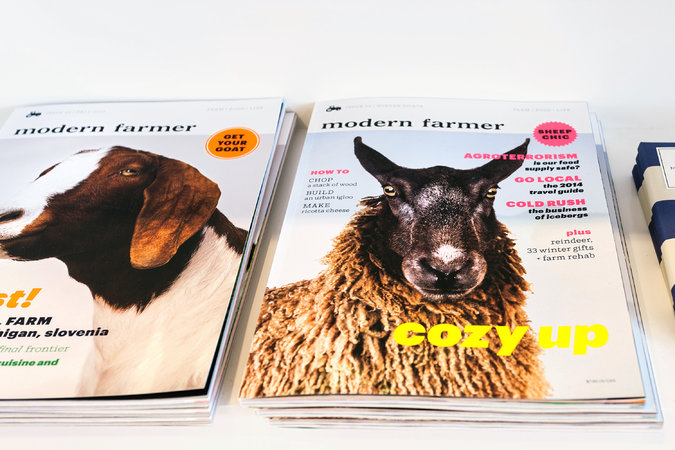Modern Farmer’s Future in Doubt
Modern Farmer’s Future in Doubt
By KIM SEVERSONJAN. 23, 2015
Credit Robert Wright for The New York Times
Modern Farmer, the quirky 100,000-circulation quarterly and website that tried to link effete urban farmers’ market culture with the practicalities of actual farming, became a magazine without an editorial staff on Friday, when its remaining paid editors walked out its doors.
With editorial operations suspended, the future of what remains of the Modern Farmer brand is uncertain.
Despite more than a million unique page views a month and support from advertisers like Dodge, Eden Foods and Shinola, the Detroit watchmaker, the magazine’s fate had been in question for months.
In December, the magazine’s founder, Ann Marie Gardner, left. The spring issue was canceled. Ms. Gardner remains in a dispute with Frank Giustra, a hard-nosed Canadian financier who owns a majority of the company.
But after the remaining editorial staff members departed Friday, Mr. Giustra’s public relations firm said in an emailed statement that plans for a summer edition were underway and any replacement hires “will continue to reflect the high standards of reporting that Modern Farmer has had in the past.”
From its start in an airy office above a Swedish cosmetics store in Hudson, N.Y., the magazine was both admired and skewered. Intended as a media and lifestyle brand for what Ms. Gardner, a former Manhattan magazine editor, liked to refer to as people who want a little more back story to their food, its initial Spring 2013 edition had a stylish rooster on the cover, an alarming feature on the problems of wild pigs and a column called Ask an Ag Minister.
The brand attracted a steady following on Facebook and Twitter and had a surprise national hit with a live animal camera that allowed viewers to watch the antics of Nigerian dwarf goats on a farm in Minnesota.
The staff also maintained an e-commerce business that sold $160 muck boots and kits to make seed bombs, which are clay balls filled with seeds that one hurls into an abandoned lot or a backyard to grow wildflowers.
But Modern Farmer had ambitious, global reporting, too, pulled together by a staff of true believers, some who had moved to upstate New York from the West Coast. It quickly won a National Magazine Award and the attention of chefs, young agrarians and food journalists.
Ms. Gardner, who built the brand with stunts like a fashion spread in Harper’s Bazaar in which she wore Gucci and Carolina Herrera among farm animals, was a well-liked editor whose hires were devoted.
Reached at her home in Hudson, Ms. Gardner said she could not speak about the matter. She remained unsure about her next move in the media world.
At the center of Modern Farmer’s collapse is the magazine’s financial performance. Mr. Giustra, who made money from mining interests, founded Lion’s Gate Entertainment and is a major contributor to the foundation headed by Bill Clinton, had been eager to move into food. He started an Italian olive oil company, invested in both industrial and small-scale farming operations and financed a specialty food company based in San Francisco.
Modern Farmer was part of that portfolio. But after a handful of issues, Mr. Giustra was disappointed in Ms. Gardner’s performance regarding early revenue figures and her ability to deliver additional investors. In the end, the chasm between the two became too wide to bridge and she left.
The staff that remained said they doubted Mr. Giustra’s commitment to funding the operation and watched the ship drift while a business manager from Albany and Ms. Gardner’s former executive assistant ran things.
Jesse Hirsch, a senior editor who came from San Francisco to help start the magazine, and Cara Parks, the executive editor who joined the staff in October, decided Thursday night that they would leave. The editorial content was left to two interns whose tenure ends Feb. 1.
“I loved Modern Farmer so much, but I can’t imagine how it can continue to be what it once was,” Ms. Parks said.
Although Modern Farmer flamed out quickly, it marked a certain period both in print media and in how American culture is relating to its food.
“It is just another example of the mainstreaming of what you might call conscientious farming,” said David Sax, the Canadian journalist whose recent book “The Tastemakers: Why We’re Crazy for Cupcakes but Fed Up With Fondue” explores American food trends.
The magazine tried to approach food from an agricultural perspective, aiming for a spot that was somewhere between the investigative advocacy of a publication like Mother Jones and the chef-driven gloss of Bon Appétit.
A result was a blend of agriculture and popular culture written by a young staff of freelancers and editors who could discuss the economic impacts of climate change with agility and treated farmers the way many food magazines treat chefs.
“There is this sense of ridiculousness around it because it is so heavily stylized,” Mr. Sax said, “but in another way it was trying to be a mouthpiece for this generation of farmers that wants to reconcile these two worlds.”
The magazine itself was part of an emerging genre of food-related publications like Lucky Peach and Cherry Bombe, which offer readers a media experience that is as much tactile as it is about content.
“It is part of a genre of very niche publications that say one thing we can do is create this beautifully designed artifact,” said the author and magazine veteran Kurt Andersen.
The problem, he said, may simply have been one of audience and execution.
“I don’t want to speak ill of the dying, but what is the plausible audience in such a magazine?” he asked. “It was too kind of nitty-gritty and old-fashioned, back-to-the-land hippie magazine for the food-farm porn market, and yet too ‘What about the dairy situation in the Philippines?’ for people who are really raising chickens for a living.”
